iMotions’ Revisiting of Yarbus’ Unexpected Visitor explores the enduring relevance of Yarbus’ seminal work in eye-tracking research. This article delves into the profound insights gained from studying eye movements and their implications for understanding human behavior. Discover the lasting impact of Yarbus’ research on modern eye-tracking methodologies.
Table of Contents
Anyone who has worked with eye tracking professionally, as a student, or even just taken an interest purely for their own enjoyment, will be familiar with the work of Alfred Yarbus. The Soviet psychologist is considered one of the paragons in facial research and is the father of one of the most famous experiments on the subject of eye tracking – the study of the painting “The Unexpected Visitor” (also sometimes referred to as “They Did Not Expect Him”) by Ilya Repin from 1888.

In his 1965 book “Eye Movements and Vision” he describes the study in which he asks people to look at the aforementioned painting seven times while being given specific instructions for each viewing. The instructions were to make judgments of the depicted scene, memorize aspects of the motif or simply look at it freely. The study showed that the subjects looked at the painting profoundly differently depending on which instruction they had been given.
Using webcam eye tracking in education
The reason why we bring up this seminal study, aside from our propensity for being nerdy within our research areas, is that we have replicated a part of Yarbus’ original study in order to test our new webcam eye tracking algorithm. Aside from it being a good validation study of our brand new algorithm, we chose to use Yarbus’ study in order to highlight one of the most exciting application areas for our iMotions Remote Data Collection Module, which the webcam eye tracking algorithm is a fundamental part of, namely in education and teaching.
You can read about the iMotions Remote Data Collection platform here, but the foundational philosophy behind the product is that you can collect data from respondents anywhere in the world provided there is internet access. The solution is also eminently scalable which makes it the ideal tool for educators teaching study- and research design.
Using a webcam to remotely collect data comes with a number of challenges, but, what it confidently can be used as, is, as mentioned above, a teaching tool.
The accuracy you give up when working without the highly specialized eye tracking hardware is quickly compensated for in sheer data collection capability. If you, as a teacher, have a cohort of students who all need to learn about cognitive psychology principles, research design, and how biosensors can elevate the understanding of cognitive principles, our Remote Data Collection is your tool.
And with that, we are back to the reason we decided to run this classic study again, to test if it is good enough for students to learn anything?
The Study of “The Unexpected Visitor” a la iMotions
Most institutions that teach the fundamentals of eye tracking will very likely use Yarbus and his experiment to teach, not just the history of eye tracking research, but also a core principle in cognition – that top-down processing matters. While there are things in our environment that ‘grab’ our attention, our prior knowledge about things, expectations from our environment, goal, and challenges at hand determine looking behavior to a much larger extent.
For years, in summer schools, conferences, and psychology classrooms, Yarbus’ seminal work has been used to discuss a variety of concepts – everything from how instruction changes physiological responses, how task-dependent eye movements can be, to how study design can change the results you get. Since this study is one of the most cited articles in the field, how cool would it be if you could actually replicate this study in a day, in your lecture? With iMotions Online you can, and we did a dry run for you to prove it!
Webcam Eye Tracking – Conducting Yarbus’ study in the 21st century
In the Remote Data Collection module, we ran 10 of our colleagues through 4 of the conditions from Yarbus’ 1965 study. Our participants had to view “The Unexpected Visitor” in four iterations. They had to
- Estimate how long the stranger had been away (first image below*)
- Gauge the material circumstances (i.e status and wealth) of the people in the picture (second image below)
- Estimate the ages of the people in the picture
- Remember the clothes they were wearing
*Images for tasks 3 & 4 are not shown for fear of inundation of near-identical images.
The study was quick to set up in the Remote Data Collection module’s intuitive study builder and took 5 minutes per participant to record. Once the data was collected and processed, making heatmaps again took the click of a button. Here you see how the heatmaps for estimating how long the visitor had been away versus estimating the material circumstances of the people in the picture look very different. As could be expected the results correspond with Yarbus’ original study, in that respondents look at the painting very differently depending on the assigned task. As can clearly be seen in the heat maps of images below, Remote Data Collection helps perfectly illustrate the difference in viewing behavior.
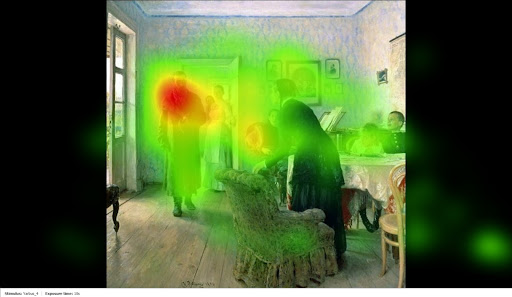
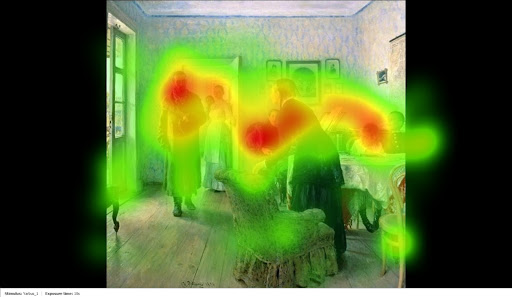
But how does this relate to your, or anyone’s, teaching practices? It is quite simple; get an iMotions OnlineData Collection Module, pick a study you want to use to teach, set it up with your students, and send out a link to the study. By the time you are ready to discuss the analysis, you would ideally have had participants for your study already and data collected*.
*It is important to note that downloading the subsequent participant data might take some time, and it is therefore not advised to attempt the download during a lecture – or at least not to wait in rapt anticipation.
Teaching with Webcam eye tracking
Even with a physical lab setup, teaching the principles and even the practicalities of eye tracking to a class have until now largely relied on theory. Partly because most labs have limited space and partly because data collection takes a long time. This is why Yarbus’ study has kept its popularity for decades in a rapidly evolving field. With iMotions Online cloud-based capabilities, you can now further strengthen your teaching by adding an easy-to-use remote data collection element, and with that give your students the opportunity to seamlessly learn theory and practicality at the same time.
If you are interested to learn how you can leverage the versatile iMotions Remote Data Collection platform for your teaching, or indeed any research that can benefit from quick setup and, potentially, global participant reach, then get in touch with our Solutions Experts here.
Yarbus with the latest webcam eye tracking software – August 2023 update
Since we did the Yarbus study, which was aimed to showcase the versatility, ease of use, and fast study setup time, we have launched a new version of the webcam eye tracking algorithm. It is called WebET 3.0 and is the core of the new iteration of our, remote data collection module.
Among the many tests we have conducted of the new algorithm, our Yarbus “recreation” study felt perfectly suited to be a juxtaposition study between the old and new algorithms. In this chapter, we show how the new algorithm is significantly more accurate than the previous version.
Below are the newly rendered heatmaps from the Yarbus recreation study
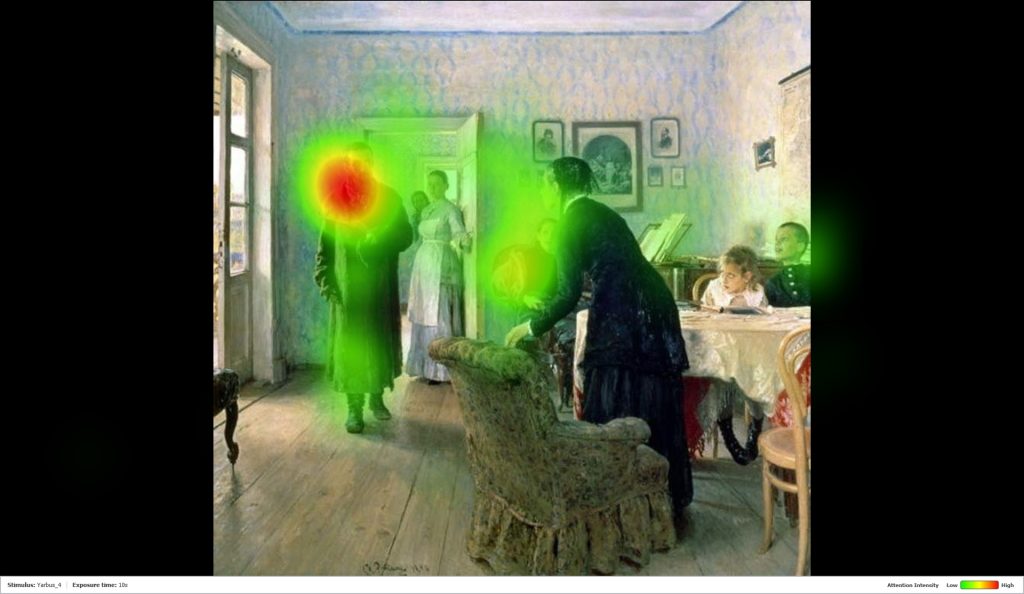
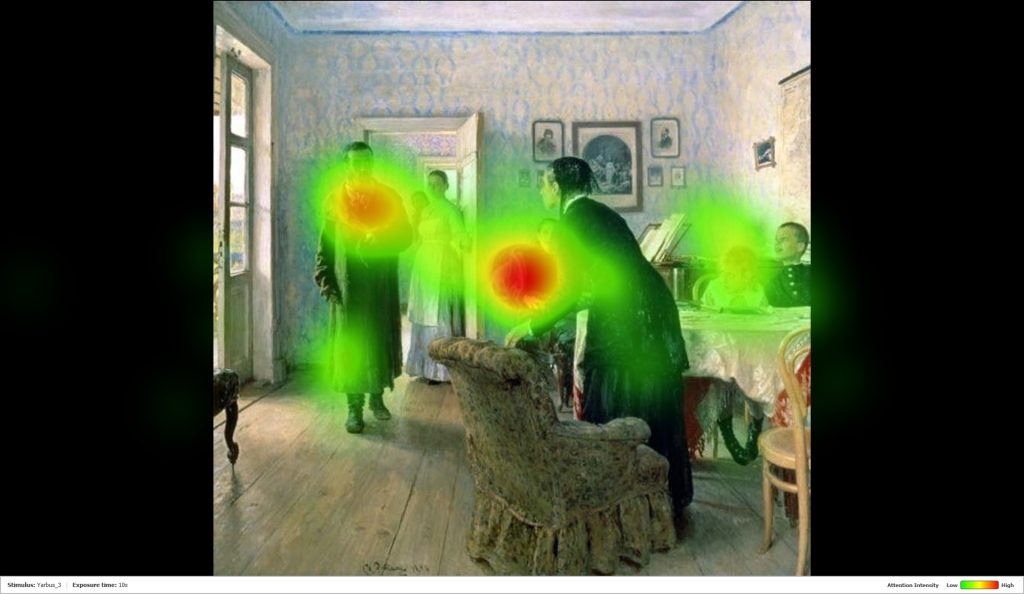
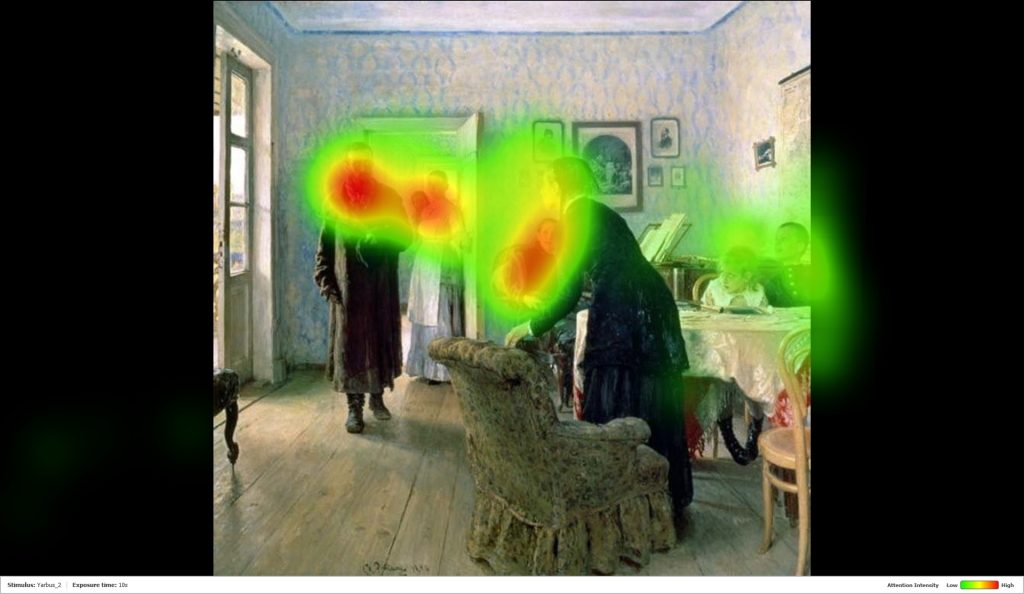
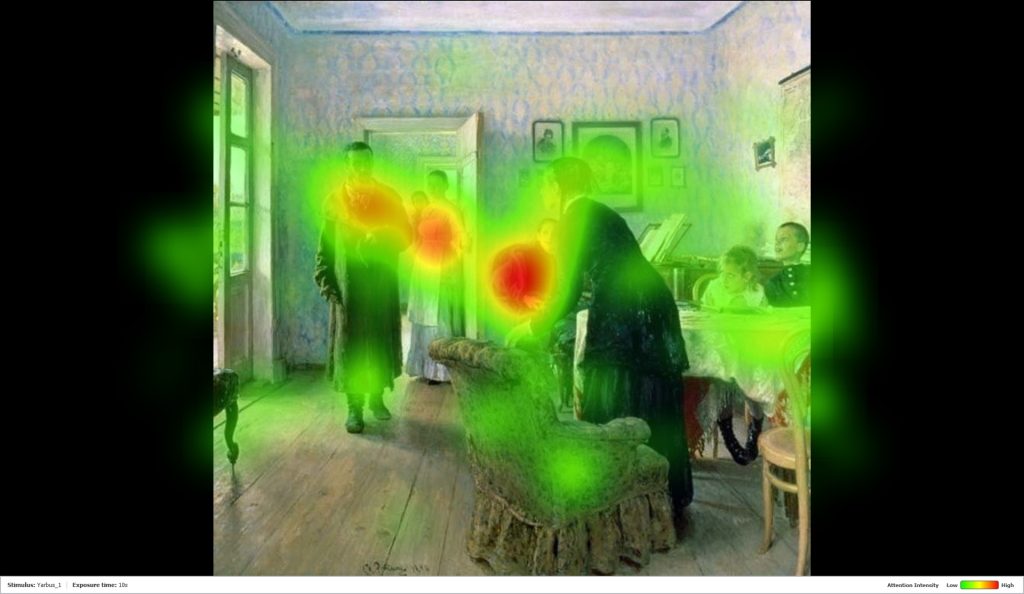
Data was recollected for Version 2.0 (N=11, accuracy < 5.0) and 3.0 (N=10, accuracy < 1.7). While the participants and datasets were different, the algorithm WebET 3.0 clearly shows less noise and one might argue is even better at distinguishing the different conditions.










